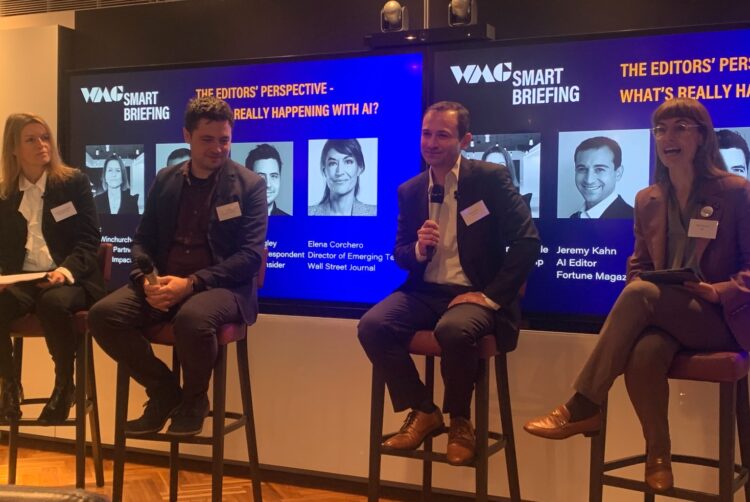‘Recalibrate expectations’: Gen AI adoption remains slow

“We need to recalibrate our expectations a bit.”
That was one takeaway from a panel of journalists and executives on the topic of AI hosted by World Media Group in London this week.
Hugh Langley, senior correspondent at Business Insider, hinted that he believes the hype around AI had perhaps got ahead of itself and that, while significant changes to industry and culture are likely to come from generative AI, they haven’t occurred as rapidly as many have expected.
“What’s starting to shake out is there is a little of a consumer problem with AI,” Langley said. “Generative AI specifically is maybe struggling to turn into a business.”
While ChatGPT, for example, is a powerful tool, many consumers consider it more of a “cool demo” than a good consumer product that people are driven to pay for to meet specific use cases, according to Langley. As such, the business model around generative AI companies, of which there are now many, is yet unclear.
“The problem with these large language models is you’re sort of trying to boil the ocean,” he continued.
Complementing other tech
Jeremy Kahn, AI editor at Fortune, added that the majority of current use cases for generative AI are indeed business-facing rather than consumer-facing. However, concerns exist around whether the technology is reliable enough to handle business-critical tasks and to what degree the cost of using models provides a legitimate return on investment.
Indeed, Kahn believes we are still in a “period of early adoption” where a “killer app” has yet to be launched. As he put it: “[Generative AI] is cool, but is it cool enough to pay £30 a month for? I don’t think so.”
On the other hand, AI is driving other tech trends. Elena Corchero, director of emerging tech at Dow Jones Live, noted that AI has caused a knock-on effect for other developing tech like the metaverse and non-fungible tokens.
“AI is kind of propelling all of the previous technologies. It’s a layer that you can add to absolutely everything… All of that investment hasn’t been in vain. All of these technologies are merging together.”
She warned, however, that businesses are not currently adequately considering the sustainable impact around generative AI, most of the cost of which is associated with energy expenditures. “When we try to infuse AI everywhere, we have to take that into consideration. Which use cases is it most essential?”
Impact on newsrooms
There remain concerns around AI-generated misinformation and disinformation. Corchero pointed to two types of misinformation from AI: the AI itself making a mistake by creating false information and users creating disinformation at mass scale using AI.
For news publishers, AI has actually made some of their work more inefficient. For example, Langley described Business Insider taking additional time to check if the Francis Scott Key Bridge collapse in Baltimore was in fact real. Similar concerns exist, said Kahn, around audio deepfakes that are more challenging to identify.
Kahn explained: “The problem also is that in the media landscape you might have a situation where mainstream, established publications do not report [said stories] at first [because they are unsure if the information is accurate], but it leaks on social media. Then everyone starts talking about it on social media, so we have to cover the fact that other people are talking about this. And then you back your way into legitimising the story. It’s going to be a big problem.”
Generation gap: Youth more trusting of advertising than older people
Tailored ‘AI agents’
At present, generative AI use cases that found success have been tailored to specific business needs. As Langley described, such “AI agents” — large language models that are tailored for very specific tasks — are being used to make “grunt work” more efficient.
“Personally, I think that’s where this will resonate more and provide value,” Langley suggested.
But for many brands, it is less clear how best to use AI more broadly in advertising. Kahn described the increasing numbers of “synthetic media companies” targeting the ad industry, selling their products as great ways to extend marketing efforts with the press of a button, such as by translating creative into different languages.
Yet there are concerns that using AI is anathema to many brand strategies.
Kahn continued: “I’ve heard other brand managers say they’re really worried about this, because they’ve spent all this time building our reputation for authenticity. We’ve been trying to make something authentic. And now we’re making something that is fundamentally inauthentic. How do you reconcile these things? Even if you have humans approving the message.”
Job concerns
Overall, much of the anxiety around AI use has also centred on whether and to what degree it will impact people’s jobs. “There’s still quite a lot of fear around job loss,” Kahn admitted.
And apparently for good reason. Some business leaders will see AI as a way to boost efficiency — and therefore cut costs in the form of headcount. Citing a recent conference he attended, Kahn said C-suite leaders talked about receiving pressure from their boards, who are asking: “We’re using this technology; when can I start taking people out of the equation?”
Kahn noted: “There’s a sentiment out there that this is what it’s for.”
But as Corchero proclaimed: “The true value of AI is in enhancing human capabilities.”
The panel was chaired by Emma Winchurch-Beale, co-president of the World Media Group and vice-president, growth partnerships, at The Economist.




